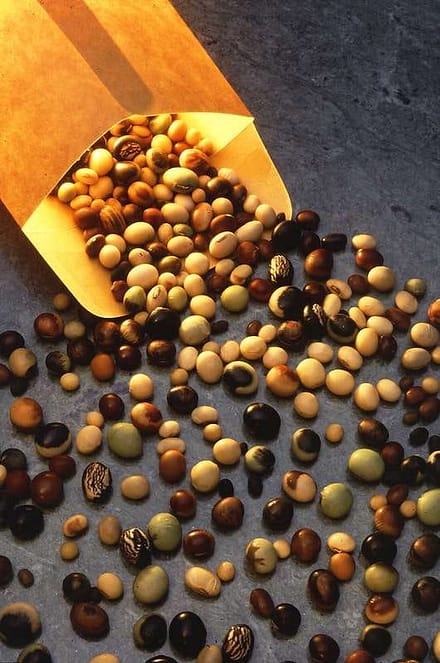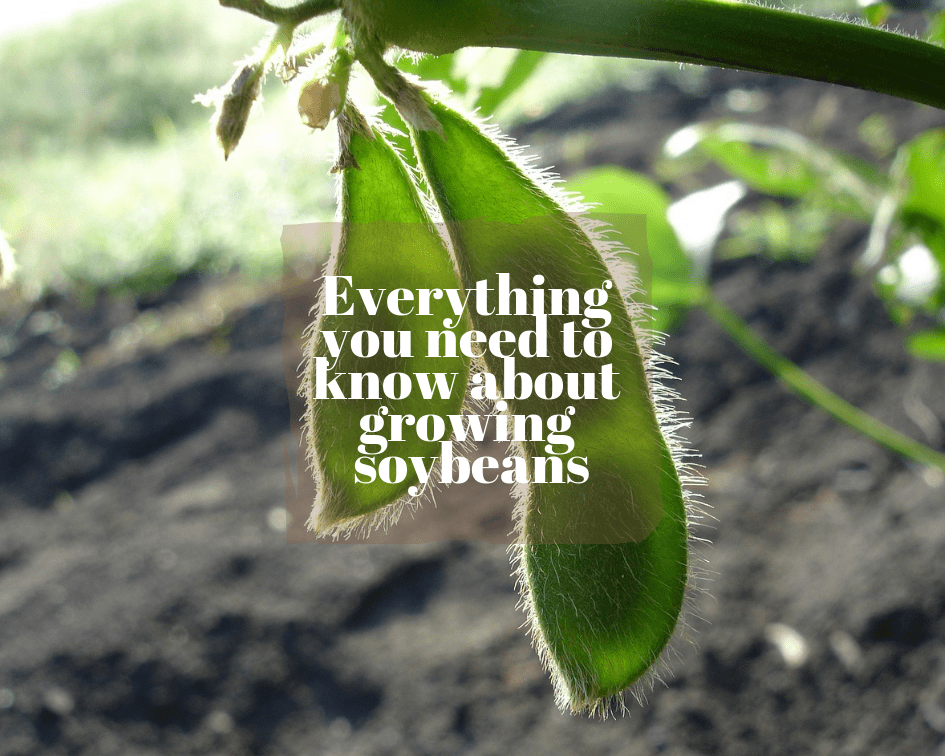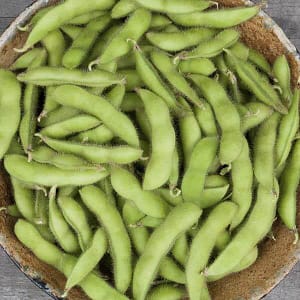This post may contain affiliate links. As an Amazon Associate we earn from qualifying purchases.
Growing soybeans (Glycine max ) to eat at home provides a non-gmo, tasty treat!
Whether you call them edamame (the young soybean), soya beans or soybeans, there is no shortage of information out there about them. The bad news is that “Most soy grown in the United States is GMO soy,” according to researchers at the National Center for Toxicological Research in Jefferson, Arkansas.
But, there is more bad news from an abstract at OxfordJournal.com. It claims that soy reduces thyroid function and promotes blood clots.
That’s all the justification we needed to find non-gmo soybeans to grow. And, we did. You can purchase them at Seeds Now and Amazon.com.
Don’t take it off the menu yet, though. According to another abstract, (National Library of Medicine), soy, if eaten during childhood, may act as a woman’s defense against breast cancer.
The verdict on soy is mixed. The one thing few people debate is that soybeans are a tasty treat and one of the few vegetables that kids will actually eat without being nagged!
Soybean Plant Facts
Native to Asia, Australia and Africa, this is an annual plant that thrives in warm weather. Growth rate for the plant varies– from almost 8 inches to 6-1/2 feet.
Soybean plants have a long taproot and they are nitrogen fixers. If you’re unaware of the benefit of growing nitrogen fixing plants, check back soon for an in-depth look at the topic. Here’s the abbreviated version.
About 80% of our planet’s atmosphere is composed of nitrogen gas, or N2, which plants can’t use. Instead, they use NH3, the ammonia form of nitrogen. From this, they manufacture a host of critical “… nitrogen-containing components necessary for life (New Mexico State University).
Luckily, certain plants, the nitrogen fixers, change the unusable N2 into into the good stuff: NH3.
How?
“In legumes and a few other plants, the nitrogen fixing bacteria live in small growths on the roots called nodules. Within these nodules, nitrogen fixation is done by the bacteria, and the NH3 they produce is absorbed by the plant. Nitrogen fixation by legumes is a partnership between a bacterium and a plant,” according to Extension agronomists at New Mexico State University.
In a nutshell, nitrogen fixing plants have bacteria that grab nitrogen gas from the air and “fix” it so that is produces compounds that plants can use.

Prepare to Plant the Soybeans
Soybean plants require full sun and. although they aren’t particular about soil, they prefer a fluffy soil. If you have icky soil (technical term there!) grow them anyway. Just amend the soil with about 2 to 3 inches of compost or aged chicken manure, mixed into the top 6 inches of the bed, before planting.
Then, you’ll need to inoculate the soya bean seeds. No, not with a “jab,” but with rhizobia bacteria. This is what creates the nodules that the soybean plant (and all legumes) need to make that unavailable nitrogen into useful stuff.
Since “Each legume species requires a specific species of rhizobia to form nodules and fix nitrogen,” you’ll want to ensure that you use the correct one.
Look for an inoculant that contains Bradyrhizobia japonica. It’s quite challenging to find at retail outlets, but Amazon at least carries an inoculant with an unnamed Bradyrhizobia species that should work for you. You’ll find it in the Resources section at the end of this post. Be sure to check the package for an expiration date before opening it. If it’s expired, return it to the seller.
If it’s good to use, store it in a cool place (below 60 degrees F) until you need it.
Plan to get the soybean seeds into the ground after the last frost, when the soil has warmed to at least 65 degrees.
Inoculating and Planting Soy Beans
You can purchase inoculant powder, here, at Amazon.com.
Plant the seeds 2 inches deep, 6 inches apart. If you are planting more than one row, space the rows 24 inches apart. Water the seeds right after planting and, if there is no rain, water again four days later.
Days to maturity is between 80 and 95.

How can I Tell if my Soil is Moist Enough for my Soybean Plants?
Watering the soybean crop is the most labor-intensive part of growing the vegetable. Although the suggested irrigation amounts are often stated in the plant’s weekly needs, split the following amounts across seven days.
We find that a blanket statement of when and how much to water any plant distasteful. And we aren’t alone. “Daily water use varies with the stage of growth and weather conditions,” explains Douglas J. Jardine, Professor Emeritus, Kansas State University. Not to mention, the type of soil you have. There truly is no one-size-fits all when it comes to watering.
Need to know the exact by-the-inch water requirements for growing soybeans? By all means, take a look at the following suggestions.
During seed development (90 to 105 days after planting), the plants need more water, so ensure that they receive 2 inches per week. Decrease the amount to water to 1.5 inches per week when the pods change color and then, just before harvest, decrease it again to 1/3 inch per week.
“The most critical time for adequate soil water availability is during the end of the reproductive period when pod fill begins,” Jardine cautions. Ensure that the soybean plants receive about 1.25 inches of water weekly up until the pods begin to elongate. This typically happens around 65 to 75 days after planting. At this point, increase the weekly water amount to 1.75 inches.
Here is a nifty trick to learn how long to water:
Grab a few tuna cans or cat food cans and place them around one of the plants. Water the way you usually do. If you use drip emitters you may have to play with the tubing to get the water to drip into the can.
Let the hose, drippers or whatever you use to water, run for it’s usual amount of time and then measure the amount of water in the cans.
This gives you an idea of how long to water to meet the plant’s requirements, in inches.
There are several other ways to determine if the moisture is getting deep enough into the soil (at least 36 inches for soybeans).

Soil Moisture Meter
Although all the rage with home gardeners, the soil moisture meters you find online frequently give off faulty readings. There are several reasons for this. First, the factory sets the soil type and there is no way to change it on the meter itself. If your soil is different, your reading may be faulty.
A buildup of salts and other minerals in the soil can cause faulty readings.
Then, quite surprisingly, soil moisture meters don’t measure moisture. “Instead they measure conductance which is a measure of the amount of electrical current flowing between two probes,” explains Robert Pavlis, author, Master Gardener and owner and developer of Aspen Grove Gardens in Ontario, Canada.
He goes on to claim, and we agree, that “There are too many variables involved: soil compaction, depth of reading, type of soil and limitations of the meter. There is no easy way to compensate for these.”
Since we’re here to learn about growing soybeans, space doesn’t permit further explanations about why you probably shouldn’t trust the inexpensive meters you buy on Amazon and other online retailers. One of Pavlis’ websites, PlantMyths.com explains it all.
The depth of moisture in the soil is important information for growing soybeans, however. The top 24 to 36 inches of soil needs to be moist so you will need a method to measure how deep you’re watering.
Probe the Soil in your Edamame Bed
Another method of measuring the depth of soil moisture when growing soybeans is with a probe, which is what we use. A probe can come in many forms, such as an appropriate length of rebar, bamboo poles or stakes or a steel tile probe. You’ll find one listed in the Resources below. Should you decide to use this tool (we love ours!) read up on suggestions to get the most of it at Utah State University Extension’s website.
WARNING: Ensure that you’re not planting over utility lines and, if you do, don’t use a probe to test the soil. The same goes for the installation of drip tubes and lines.
If you’re unsure about what lies beneath the soil, call 811, a nationwide helpline that will reroute you to your local “call-before-you-dig hotline.” Don’t take chances, please. We kinda like you!
 Fertilizing, or Not Fertilizing the Soybean Plant
Fertilizing, or Not Fertilizing the Soybean Plant
“Attempts to supplement the legume nitrogen supply by fertilization usually are counterproductive, because plants tend to stop nitrogen fixation when soil nitrogen is high,” caution the experts at Colorado State University. They go on to say that the phosphorous and potassium in fertilizer may positively impact the growing soybean plant’s nitrogen fixation.
“Research shows that additions of phosphorous and/or potassium increase the number of nodules formed, fresh weight of nodules, and amount of nitrogen fixed per nodule.”
In reality, most professional growers don’t fertilize their soybean crops. Legumes are the nitrogen superheroes. Your plants really won’t need any supplemental fertilizer if you amended the soil properly before planting.
Harvesting Soybean Plant
Harvest the soybean pods when they are full. This generally occurs about 85 days after planting.
A better indicator is to wait until at least 95% of the pods have turned brown and feel firm to the touch, according to Gary Zoubek, Roger Wilson and Chuck Burr with the University of Nebraska-Lincoln.
If you prefer edamame, the young soybean, harvest when the pods are plump, turn a light green and the soybeans are almost touching. Don’t wait too long when they reach this point because they mature quite fast.

Soybean and Edamame Pests and Diseases
Mexican bean and Japanese beetles are attracted to the soybean plant . They can be controlled with a number of insecticides such as Sevin dust. If you don’t want to use chemicals (and I don’t blame you), try Azatrol Botanical Insecticide (available at Amazon.com) or Milky Spore, which kills the Japanese beetle in the grub stage.
The former (Azatrol), by the way, is distilled from the neem tree’s seeds, although it is not neem oil.
Look out for armyworms as well — they can decimate an entire crop overnight. Monterey Garden Insect Spray with spinosad is a good choice to rid them from the garden.
Edamame plant diseases
Bacterial and wilt disease are two that are common among all bean plants. High heat and humidity are necessary for these diseases to occur and they can be prevented.
Stressed plants, such as by injury, high soil pH and nutritional deficiencies, are most at risk of infections. If the plant does become infected, it will require more water than normal because the root system is compromised.
Fungicides listed for broad spectrum disease control are the recommended treatment (our favorite is a Bonide product, available at Amazon.)
Soybean rust is another disease you may have to battle. In fact, the experts at the University of Minnesota Extension claim it is “. . . potentially one of the most significant diseases of soybean.” It spreads very quickly and “… can cause leaf spots and defoliation of soybean plants.”
You’ll notice symptoms on the lower leaves first. These consist of light or reddish brown spots on the back of the leaves. Then, the tops of the leaves are affected (see the photo on the right).
The trick to defeating this disease is to catch it early, so check your soybean plants often. While there are ongoing studies to create an organic fungicidal solution, the only choices currently available contain chemicals. For information on what to use in your area, call your county’s Cooperative Extension Service.







